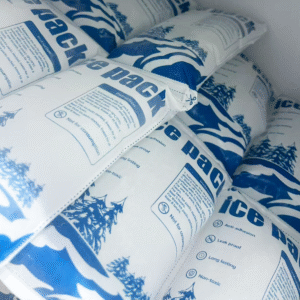كيفية استخدام عبوات الثلج الجاف لشحن المأكولات البحرية: دليل كامل
Shipping seafood requires careful attention to temperature control. To ensure that your seafood reaches its destination fresh and safe for consumption, dry ice packs are an essential tool. These packs are particularly beneficial when shipping seafood over long distances, where maintaining a cold temperature is critical. This guide explores how to use dry ice packs for seafood and ensures the best shipping practices.
-
Why dry ice packs are crucial for shipping seafood.
-
How to select the right dry ice pack for your seafood shipments.
-
What safety measures should you follow when using dry ice?
-
What are the benefits of using dry ice packs over other cooling options?
Why Use Dry Ice Packs for Shipping Seafood?
Dry ice packs offer an effective solution for maintaining low temperatures during seafood transport. الجليد الجاف, وهو ثاني أكسيد الكربون الصلب (co₂), يتسامى عند -78.5 درجة مئوية, creating a cooling effect that is perfect for seafood, which needs to stay frozen or at a low temperature to prevent spoilage. عن طريق اختيار كيس الثلج الجاف المناسب, you can ensure that the seafood stays fresh from point A to point B.
The main benefit of dry ice for seafood shipping is its ability to keep the contents cold without the need for refrigeration. على عكس الجليد التقليدي, الجليد الجاف لا يذوب في الماء, which eliminates the risk of wet packaging that could damage seafood. بالإضافة إلى ذلك, dry ice can maintain the required low temperatures for extended periods, مما يجعلها مثالية للشحنات لمسافات طويلة.
| مميزة | وصف | Benefits for Seafood |
|---|---|---|
| نطاق درجة الحرارة | -78.5درجة مئوية | Keeps seafood frozen during long shipments |
| معدل التسامي | 5-10 رطل لكل 24 ساعات | Ensures consistent temperature control |
| لوائح الشحن | تخضع لقواعد DOT وIATA | Compliant with safety standards |
Choosing the Right Dry Ice Pack for Seafood
عند شحن المأكولات البحرية, selecting the correct dry ice pack is essential. The ideal pack size depends on the type and volume of seafood, as well as the shipping time. عمومًا, larger quantities of seafood require larger packs to ensure temperature control throughout the transit period.
للشحنات بين عشية وضحاها, a smaller dry ice pack might suffice, as it will keep the seafood chilled for 24-48 ساعات. لأوقات شحن أطول, use larger packs to provide consistent cooling over extended periods. Multiple smaller packs can also be used to optimize cooling performance. For delicate seafood types like oysters or fish, additional insulation or multiple dry ice packs may be necessary to maintain a stable temperature.
Best Practices for Using Dry Ice Packs in Seafood Shipping
-
Understand your seafood’s temperature needs: Different seafood requires different temperature controls. على سبيل المثال, shrimp may need a colder environment than other types of fish.
-
Calculate the amount of dry ice needed: Consider the shipping duration and ambient temperature. عمومًا, the more dry ice you use, the longer your products will stay cold.
-
التأكد من التغليف المناسب: Use insulated containers to maximize the cooling effect of dry ice. The packaging should also be vented to allow the sublimation gases to escape safely.
How Do Dry Ice Packs Keep Seafood Fresh?
Dry ice packs work by sublimating into carbon dioxide gas, امتصاص الحرارة من البيئة المحيطة. The solid dry ice turns into gas, creating a cooling effect that lowers the temperature of the seafood and keeps it frozen.
The cooling effect lasts longer than regular ice because dry ice doesn’t melt into water, preventing seafood from getting wet. It’s especially useful for shipping frozen seafood over long distances, as it maintains consistent temperatures until delivery.
Example Scenario
When shipping lobster or crab, dry ice can maintain the necessary freezing temperatures while ensuring that the seafood does not thaw during transit. This is especially crucial for maintaining the texture and flavor of the products.
Safety Measures When Using Dry Ice
في حين أن الثلج الجاف فعال للغاية, it requires proper handling to ensure safety. Here are the key safety precautions:
-
تهوية: يطلق الثلج الجاف غاز ثاني أكسيد الكربون, which can be dangerous in poorly ventilated areas. Always store and ship dry ice in well-ventilated containers.
-
معدات الحماية: Handle dry ice with insulated gloves to prevent frostbite from contact with the extremely cold material.
-
التعبئة والتغليف ووضع العلامات: Ensure that your packaging is durable and that you label the package as containing dry ice. Proper labeling helps carriers handle shipments with care.
| اعتبارات السلامة | فعل | لماذا هو مهم |
|---|---|---|
| تهوية | Use in well-ventilated spaces | منع تراكم CO₂, which can be dangerous |
| معدات الحماية | Wear gloves when handling dry ice | Prevent frostbite and injuries |
| التغليف & وضع العلامات | Use vented containers and label properly | Ensure safe handling and compliance with regulations |
2025 Trends in Seafood Shipping
The seafood shipping industry is evolving with the development of new technologies and strategies aimed at improving cold chain logistics. Here are some of the trends for 2025:
مراقبة درجة الحرارة الذكية
Using sensors that track the temperature of seafood shipments in real-time. This helps ensure that the product remains at the required temperature throughout transit.
عبوة مستدامة
As environmental concerns increase, companies are moving towards eco-friendly and biodegradable packaging solutions, reducing the carbon footprint of shipping processes.
Innovations in Shipping Technologies
-
Temperature-Sensitive Packaging: Advances in packaging materials help retain low temperatures for longer periods, providing more reliable and cost-effective solutions.
-
Blockchain للتتبع: Blockchain technology ensures greater transparency and traceability in the cold chain, helping businesses confirm that seafood was handled properly during the shipping process.
رؤى السوق
As consumer demand for fresh and sustainable seafood grows, businesses are investing in better cold chain solutions. The global cold chain market is expected to exceed $700 مليار من قبل 2025, driven by advancements in refrigeration and packaging technologies.
الأسئلة المتداولة
س 1: What is the best way to pack seafood with dry ice?
Always use an insulated container with proper ventilation for dry ice. Ensure that the seafood is tightly packed and doesn’t move around, as movement can cause thawing.
Q2: كم من الوقت سوف يحافظ الثلج الجاف على المأكولات البحرية مجمدة أثناء الشحن?
Dry ice can keep seafood frozen for up to 48 ساعات, depending on the size of the pack and the ambient temperature. Larger packs are recommended for longer shipping durations.
الخلاصة والتوصيات
في ملخص, dry ice packs are a crucial element for shipping seafood, ensuring it stays fresh and safe for consumption. By choosing the right size and following safety guidelines, you can ensure that your seafood shipments arrive in perfect condition.
الخطوات التالية:
-
Choose the appropriate size dry ice pack for your seafood shipment.
-
Ensure all safety protocols are followed when handling and packaging dry ice.
-
Invest in advanced monitoring technology to track temperatures during transit.
حول Tempk
و Tempk, we specialize in providing reliable dry ice packs tailored to the seafood industry. With years of experience and a commitment to high-quality solutions, we help ensure your seafood shipments are fresh, آمن, and delivered on time.
























